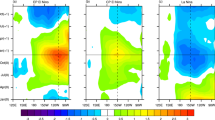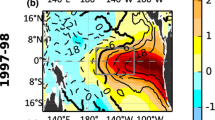Abstract
Amplitude of El Niño and La Niña was significantly different during 1980–2016 but almost same during 1958–1979. The cause of this interdecadal change is investigated through an oceanic mixed-layer heat budget analysis. It was found that this interdecadal change was primarily attributed to the distinctive effects of nonlinear zonal temperature advection between the two periods. During 1980–2016 nonlinear zonal advection, working together with nonlinear meridional advection, contributes to the El Niño and La Niña amplitude asymmetry. During 1958–1979 the nonlinear zonal advection had an opposite effect. The difference in the nonlinear zonal advection between the two interdecadal periods was caused by distinctive longitudinal locations of El Niño centers. Maximum SST anomaly (SSTA) centers were confined near the coast of South America (east of 90° W) during the first period but appear near 110° W during the second period. Because of this difference, an anomalous eastward ocean surface current (caused by a positive thermocline depth anomaly during El Niño) would generate a negative (positive) nonlinear zonal advection before (after) 1980. The distinctive longitudinal locations of El Niño centers are possibly caused by the interdecadal changes of mean thermocline and high-frequency wind variability over the equatorial western-central Pacific. A hypothesis was put forth to understand distinctive initiation locations between El Niño and La Niña.














Similar content being viewed by others
References
An SI (2004) Interdecadal changes in the El Niño-La Niña asymmetry. Geophys Res Lett 31:L23210
An SI, Jin FF (2004) Nonlinearity and asymmetry of ENSO. J Clim 17(14):2851–2865
An SI, Hsieh WW, Jin FF (2005) A nonlinear analysis of the ENSO cycle and its interdecadal changes. J Clim 18:3229–3239
Battisti DS, Hirst AC (1989) Interannual variability in a tropical atmosphere-ocean model: influence of the basic state, ocean geometry and nonlinearity. J Atmos Sci 46(12):1687–1712
Behringer DW (2007) The Global Ocean Data Assimilation System (GODAS) at NCEP. In: Preprints 11th Symp. on integrated observing and assimilation systems for atmosphere, oceans, and land surface, San Antonio, TX, Amer Meteor Soc, 3.3
Bove MC, O’Brien JJ, Eisner JB et al (1998) Effect of El Niño on US Landfalling hurricanes, revisited. Bull Am Meteorol Soc 79(11):2477–2482
Burgers G, Stephenson DB (1999) The “normality” of El Niño. Geophys Res Lett 26(8):1027–1030
Cai W et al (2014) Increasing frequency of extreme El Niño events due to greenhouse warming. Nat Clim Change 4:111–116
Cane MA, Zebiak SE (1985) A theory for El Niño and the Southern oscillation. Science 228(4703):1085–1087
Capotondi A, Sardeshmukh PD, Ricciardulli L (2018) The nature of the stochastic wind forcing of ENSO. J Clim 31(19):8081–8099
Carton JA, Giese BS (2008) A reanalysis of ocean climate using simple ocean data assimilation (SODA). Mon Weather Rev 136(136):2999–3017
Carton JA, Chepurin G, Cao X et al (2000) A simple ocean data assimilation analysis of the global upper ocean 1950–95. Part I: methodology. J Phys Oceanogr 30(2):294–309
Chang P, Wang B, Li T, Ji L (1994) Interactions between the seasonal cycle and the Southern Oscillation: frequency entrainment and chaos in an intermediate coupled ocean atmosphere model. Geophys Res Lett 21:2817–2820
Changnon SA (1999) Impacts of 1997-98 El Niño Generated Weather in the United States. Bull Am Meteorol Soc 80(9):1819–1827
Chen L, Li T, Yu Y (2015) Causes of strengthening and weakening of enso amplitude under global warming in four CMIP5 models. J Clim 28:3250–3274
Chen L, Li T, Behera SK, Doi T (2016a) Distinctive precursory air-sea signals between regular and super El Niños. Adv Atmos Sci 33:996–1004
Chen L, Yu Y, Zheng W (2016b) Improved ENSO simulation from climate system model FGOALS-g1.0 to FGOALS-g2. Clim Dyn 47:2617–2634
Chen M, Li T, Shen X et al (2016c) Relative roles of dynamic and thermodynamic processes in causing evolution asymmetry between El Niño and La Niña. J Clim 29(6):2201–2220
Chen L, Li T, Yu Y, Behera SK (2017a) A possible explanation for the divergent projection of ENSO amplitude change under global warming. Clim Dyn 49:3799–3811
Chen L, Li T, Wang B, Wang L (2017b) Formation mechanism for 2015/16 super El Niño. Sci Rep 7:2975
Chen L, Zheng W, Braconnot P (2019) Towards understanding the suppressed ENSO activity during mid-Holocene in PMIP2 and PMIP3 simulations. Clim Dyn 53(1–2):1095–1110
Choi J, An SI, Dewitte B, Hsieh WW (2009) Interactive feedback between the tropical Pacific decadal oscillation and ENSO in a coupled general circulation model. J Clim 22:6597–6611
Chung PH, Li T (2013) Interdecadal relationship between the mean state and El Niño types. J Clim 26(2):361–379
Collins M et al (2010) The impact of global warming on the tropical Pacific and El Niño. Nat Geosci 3:391–397
Compo GP, Whitaker JS, Sardeshmukh PD (2006) Feasibility of a 100-year reanalysis using only surface pressure data. Bull Am Meteorol Soc 87(2):175–190
Dee DP, Uppala SM, Simmons AJ et al (2011) The era-interim reanalysis: configuration and performance of the data assimilation system. Q J R Meteorol Soc 137(656):553–597
Dong B, Sutton RT, Scaife AA (2006) Multidecadal modulation of El Niño-Southern Oscillation (ENSO) variance by Atlantic Ocean sea surface temperatures. Geophys Res Lett 33:L08705
Hong CC, Li T, Kug JS (2008) Asymmetry of the Indian Ocean dipole. Part I: observational analysis. J Clim 21(18):4834–4848
Hu ZZ, Kumar A, Jha B et al (2012) An analysis of warm pool and cold tongue El Niños: air-sea coupling processes, global influences, and recent trends. Clim Dyn 38(9–10):2017–2035
Huang R, Wu Y (1989) The influence of ENSO on the summer climate change in China and its mechanism. Adv Atmos Sci 6(1):21–32
Huang B, Xue Y, Zhang D et al (2010) The NCEP GODAS ocean analysis of the tropical Pacific mixed layer heat budget on seasonal to interannual time scales. J Clim 23(18):4901–4925
Jin FF (1997) An equatorial ocean recharge paradigm for ENSO. Part I: Conceptual model. J Atmos Sci 54(7):811–829
Jin FF, An SI, Timmermann A et al (2003) Strong El Niño events and nonlinear dynamical heating. Geophys Res Lett 30(3):20-1–20-4
Kanamitsu M, Ebisuzaki W, Woollen J et al (2002) NCEP–DOE AMIP-II reanalysis (R-2). Bull Am Meteorol Soc 83(11):1631–1643
Kang IS, No HH, Kucharski F (2014) ENSO amplitude modulation associated with the mean SST changes in the tropical central Pacific induced by Atlantic multidecadal oscillation. J Clim 27:7911–7920
Kirtman BP, Schopf PS (1998) Decadal variability in ENSO predictability and prediction. J Clim 11(11):2804–2822
Kumar A, Hu ZZ (2012) Uncertainty in the ocean-atmosphere feedbacks associated with ENSO in the reanalysis products. Clim Dyn 39(3–4):575–588
Li T (1997) Phase transition of the El Niño-Southern Oscillation: a Stationary SST Mode. J Atmos Sci 54(54):2872–2887
Li T, Hsu PC (2017) ENSO dynamics. Fundamentals of tropical climate dynamics. Springer International Publishing, Cham, p 236
Li T, Zhang Y, Lu E, Wang D (2002) Relative role of dynamic and thermodynamic processes in the development of the Indian Ocean dipole: an OGCM diagnosis. Geophys Res Lett 29:25-21–25-24
Li T, Wang B, Wu B et al (2017) Theories on formation of an anomalous anticyclone in Western North Pacific during El Niño: a review. J Meteorol Res 31(6):987–1006
Li X, Hu ZZ, Huang B (2019) Contributions of atmosphere-ocean interaction and low-frequency variation to intensity of strong El Niño events since 1979. J Clim 32(5):1381–1394
Mcphaden MJ, Zebiak SE, Glantz MH (2006) ENSO as an integrating concept in earth science. Science 314(5806):1740–1745
Neelin JD, Battisti DS, Hirst AC et al (1998) ENSO theory. J Geophys Res Oceans 103(C7):14261–14290
Okumura YM, Deser C (2010) Asymmetry in the duration of El Niño and La Niña. J Clim 23(21):5826–5843
Okumura YM, Sun T, Wu X (2017) Asymmetric modulation of El Niño and La Niña and the linkage to tropical Pacific decadal variability. J Clim 30:4705–4733
Philander SG (1990) El Niño, La Niña, and the Southern Oscillation. Academic Press, London, p 289
Philander SGH, Yamagata T, Pacanowski RC (1984) Unstable air-sea interactions in the tropics. J Atmos Sci 41(4):604–613
Picaut J, Masia F, Penhoat YD (1997) An advective-reflective conceptual model for the oscillatory nature of the ENSO. Science 277(5326):663–666
Rasmusson EM, Carpenter TH (1982) Variations in Tropical Sea Surface Temperature and Surface Wind Fields Associated with the Southern Oscillation/El Niño. Mon Weather Rev 110(5):354–384
Rodgers KB, Friederichs P, Latif M (2004) Tropical Pacific decadal variability and its relation to decadal modulations of ENSO. J Clim 17:3761–3774
Ropelewski CF, Halpert MS (1987) Global and regional scale precipitation patterns associated with the El Niño/Southern oscillation. Mon Weather Rev 115:1606–1626
Smith TM, Reynolds RW, Peterson TC et al (2008) Improvements to NOAAs historical merged land-ocean surface temperature analysis (1880–2006). J Clim 21(10):2283–2296
Su JZ, Zhang RH, Rong XY et al (2010) Causes of the El Niño and La Niña amplitude asymmetry in the equatorial eastern Pacific. J Clim 23(3):605–617
Suarez MJ, Schopf PS (1988) A delayed action oscillator for ENSO. J Atmos Sci 45(21):3283–3287
Uppala SM, Kallberg PW, Simmons AJ et al (2005) The ERA-40 re-analysis. Q J R Meteorol Soc 131(612):2961–3012
Wallace JM, Gutzler DS (1981) Teleconnections in the geopotential height field during the Northern Hemisphere winter. Mon Weather Rev 109(4):784–812
Wang B, An SI (2001) Why the properties of El Niño changed during the late 1970s. Geophys Res Lett 28(19):3709–3712
Wang B, Wu R, Fu X (2000) Pacific-East Asian teleconnection: how does ENSO affect east Asian climate? J Clim 13(9):1517–1536
Wang B, Wu R, Li T (2003) Atmosphere–warm ocean interaction and its impacts on Asian-Australian Monsoon variation. J Clim 16:1195–1211
Weisberg RH, Wang C (1997) A Western Pacific oscillator paradigm for the El Niño-Southern Oscillation. Geophys Res Lett 24(7):779–782
White GH (1980) Skewness, kurtosis and extreme values of northern hemisphere geopotential heights. Mon Weather Rev 108(9):1446–1455
Wu B, Li T, Zhou TJ (2010) Asymmetry of atmospheric circulation anomalies over the western North Pacific between El Niño and La Niña. J Clim 23(18):4807–4822
Wu B, Zhou TJ, Li T (2017) Atmospheric dynamic and thermodynamic processes driving the western North Pacific anomalous anticyclone during El Niño. Part I: maintenance mechanisms. J Clim 30:9621–9635
Xiang B, Wang B, Li T (2013) A new paradigm for the predominance of standing central Pacific warming after the late 1990s. Clim Dyn 41(2):327–340
Xue Y, Smith TM, Reynolds RW (2003) Interdecadal changes of 30-Yr SST normals during 1871–2000. J Clim 16(10):1601–1612
Yeh SW, Kirtman BP (2004) Tropical Pacific decadal variability and ENSO amplitude modulation in a CGCM. J Geophys Res 109:C11009
Yeo SR, Yeh SW, Kim KY et al (2016) The role of low frequency variation in the manifestation of warming trend and ENSO amplitude. Clim Dyn 49(4):1197–1213
Zhu ZW, Li T (2016) A new paradigm for continental US summer rainfall variability: Asia-North America teleconnection. J Clim 29:7313–7327
Zhu ZW, Li T (2018) Amplified contiguous United States summer rainfall variability induced by East Asian monsoon interdecadal change. Clim Dyn 50(9–10):3523–3536
Acknowledgements
This work was supported by NSFC Grants 41630423, NSF Grant AGS-15-65653, NOAA Grant NA18OAR4310298, and Jiangsu NSF grant BK20180811. This is SOEST contribution number 10864, IPRC contribution number 1416, and ESMC contribution number 291.
Author information
Authors and Affiliations
Corresponding author
Additional information
Publisher's Note
Springer Nature remains neutral with regard to jurisdictional claims in published maps and institutional affiliations.
Rights and permissions
About this article
Cite this article
Pan, X., Li, T. & Chen, M. Change of El Niño and La Niña amplitude asymmetry around 1980. Clim Dyn 54, 1351–1366 (2020). https://doi.org/10.1007/s00382-019-05062-y
Received:
Accepted:
Published:
Issue Date:
DOI: https://doi.org/10.1007/s00382-019-05062-y




